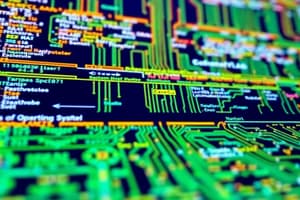Podcast
Questions and Answers
What is the primary function of the kernel in an operating system?
What is the primary function of the kernel in an operating system?
- Providing common services to computer programs
- Managing user interactions
- Performing system backups
- Managing hardware resources (correct)
What type of operating system allows multiple users to perform multiple tasks simultaneously?
What type of operating system allows multiple users to perform multiple tasks simultaneously?
- Single-user, single-tasking
- Single-user, multi-tasking
- Multi-user, multi-tasking (correct)
- Multi-user, single-tasking
Which of the following is NOT a function of an operating system?
Which of the following is NOT a function of an operating system?
- Security
- Process management
- I/O management
- Compiling code (correct)
What is the primary focus of Human-Computer Interaction (HCI)?
What is the primary focus of Human-Computer Interaction (HCI)?
Which HCI design principle involves making system status visible to users?
Which HCI design principle involves making system status visible to users?
What is the purpose of device drivers in an operating system?
What is the purpose of device drivers in an operating system?
What is the interaction cycle in HCI?
What is the interaction cycle in HCI?
What is the purpose of system libraries in an operating system?
What is the purpose of system libraries in an operating system?
Flashcards are hidden until you start studying
Study Notes
Operating Systems
Definition and Functions
- A software that manages computer hardware resources and provides common services to computer programs
- Functions:
- Process management: creating, running, and managing processes
- Memory management: allocating and deallocating memory
- File management: creating, deleting, and managing files
- I/O management: managing input/output operations
- Security: controlling access to computer resources
Types of Operating Systems
- Single-user, single-tasking: allows one user to perform one task at a time (e.g., MS-DOS)
- Multi-user, single-tasking: allows multiple users to perform one task at a time (e.g., early Unix)
- Single-user, multi-tasking: allows one user to perform multiple tasks simultaneously (e.g., Windows, macOS)
- Multi-user, multi-tasking: allows multiple users to perform multiple tasks simultaneously (e.g., modern Unix, Linux)
Operating System Components
- Kernel: core part of the OS that manages hardware resources
- Device drivers: software that interacts with hardware devices
- System libraries: pre-written code that provides common functions
- System utilities: programs that perform specific tasks (e.g., disk formatting, backup)
Human-Computer Interaction (HCI)
Definition and Importance
- The study of how people interact with computers and how to design computers that are easy to use
- Importance: affects user experience, productivity, and safety
HCI Design Principles
- Visibility: making system status visible to users
- Affordance: designing interfaces that suggest how to use them
- Feedback: providing users with feedback on their actions
- Constraints: limiting user actions to prevent errors
- Consistency: using consistent design elements throughout the interface
HCI Design Models
- Interaction cycle: a model that describes the steps involved in human-computer interaction
- User intention
- Translation of intention into action
- Execution of action
- System response
- User interpretation of response
- GOMS (Goals, Operators, Methods, and Selection rules): a model that describes how users achieve goals using operators and methods
HCI Evaluation Methods
- Heuristic evaluation: evaluating an interface using design principles and guidelines
- User testing: observing users interacting with a system to identify usability issues
- Cognitive walkthroughs: analyzing an interface by walking through it step-by-step to identify usability issues
Operating Systems
Definition and Functions
- Manages computer hardware resources and provides common services to computer programs
- Key functions include:
- Process management: creating, running, and managing processes
- Memory management: allocating and deallocating memory
- File management: creating, deleting, and managing files
- I/O management: managing input/output operations
- Security: controlling access to computer resources
Types of Operating Systems
- Single-user, single-tasking OS: allows one user to perform one task at a time (e.g., MS-DOS)
- Multi-user, single-tasking OS: allows multiple users to perform one task at a time (e.g., early Unix)
- Single-user, multi-tasking OS: allows one user to perform multiple tasks simultaneously (e.g., Windows, macOS)
- Multi-user, multi-tasking OS: allows multiple users to perform multiple tasks simultaneously (e.g., modern Unix, Linux)
Operating System Components
- Kernel: core part of the OS that manages hardware resources
- Device drivers: software that interacts with hardware devices
- System libraries: pre-written code that provides common functions
- System utilities: programs that perform specific tasks (e.g., disk formatting, backup)
Human-Computer Interaction (HCI)
Definition and Importance
- Study of how people interact with computers and how to design computers that are easy to use
- Importance: affects user experience, productivity, and safety
HCI Design Principles
- Visibility: making system status visible to users
- Affordance: designing interfaces that suggest how to use them
- Feedback: providing users with feedback on their actions
- Constraints: limiting user actions to prevent errors
- Consistency: using consistent design elements throughout the interface
HCI Design Models
- Interaction cycle: a model that describes the steps involved in human-computer interaction
- User intention
- Translation of intention into action
- Execution of action
- System response
- User interpretation of response
- GOMS (Goals, Operators, Methods, and Selection rules): a model that describes how users achieve goals using operators and methods
HCI Evaluation Methods
- Heuristic evaluation: evaluating an interface using design principles and guidelines
- User testing: observing users interacting with a system to identify usability issues
- Cognitive walkthroughs: analyzing an interface by walking through it step-by-step to identify usability issues
Studying That Suits You
Use AI to generate personalized quizzes and flashcards to suit your learning preferences.




